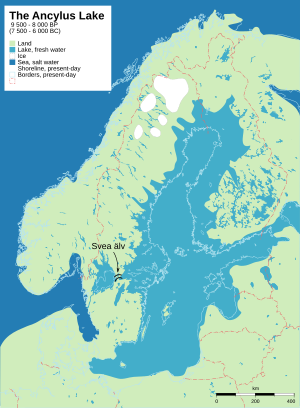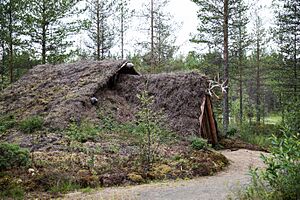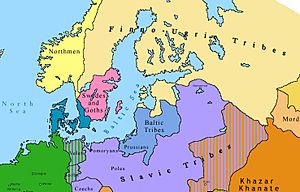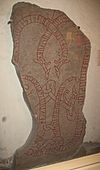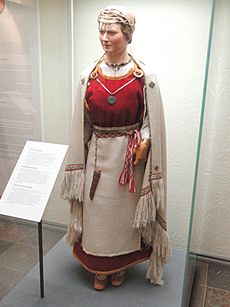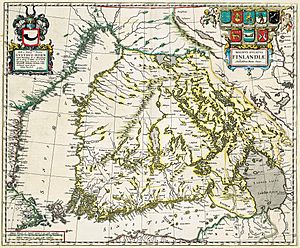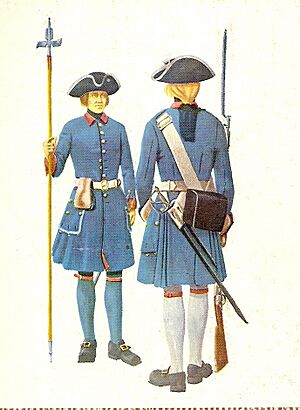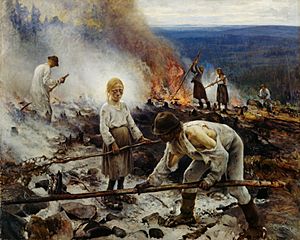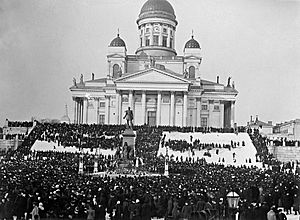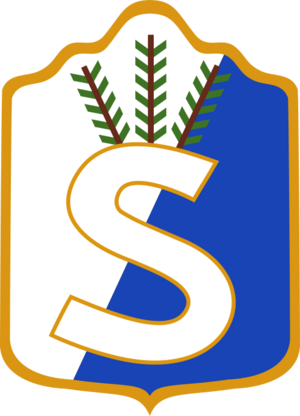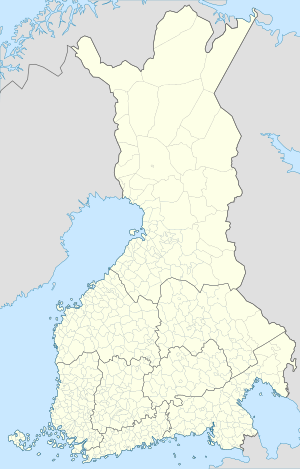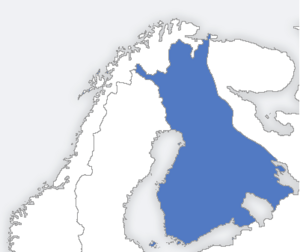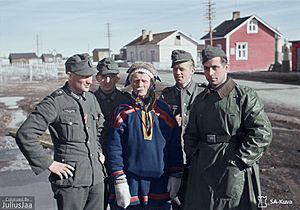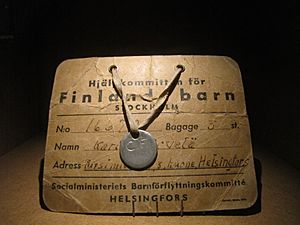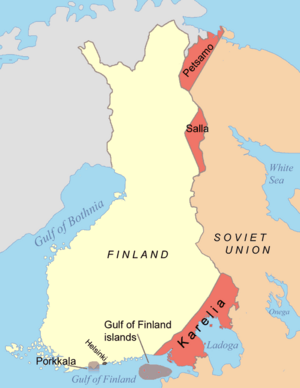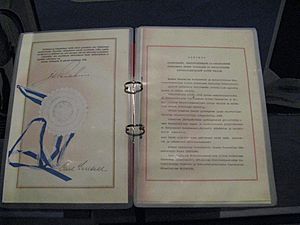History of Finland facts for kids
The history of Finland started around 9,000 BC. This was when the last ice age ended. Early people lived as hunter-gatherers. Later, different Stone Age cultures developed. The Bronze Age began around 1,500 BC. The Iron Age followed, lasting until 1,300 AD. Written records about Finland started appearing in the 12th century. This was when the Catholic Church became important in Southwest Finland.
Finland became part of the Kingdom of Sweden and the Catholic Church from the 13th century. This happened after the Northern Crusades and Swedish settlement in some coastal areas. In 1809, after the Finnish War, Finland became part of the Russian Empire. It was an independent area called the Grand Duchy of Finland. The Lutheran religion was dominant. In the 1800s, Finnish nationalism grew. People became proud of Finnish culture, language, and stories like the Kalevala. A terrible famine in the 1860s led to more people leaving Finland.
Finland declared independence in 1917. A civil war followed in 1918. The "Whites" won against the "Reds." After the war, Finland's economy grew. It had strong ties with Western countries. During World War II, Finland fought the Soviet Union twice. It lost some land, but stayed an independent democracy. After the war, Finland became a mixed economy. Its wealth grew, and it built a strong welfare state. Finland joined the European Union in 1995. It started using the euro currency in 2002. In 2023, Finland joined NATO after the Russian invasion of Ukraine.

Contents
Early History: Stone, Bronze, and Iron Ages

Stone Age Life
The oldest possible human site in Finland is the Wolf Cave. It is in Kristinestad and is about 125,000 years old. This would be the only pre-glacial site in the Nordic countries.
The last ice age ended around 9000 BC. People then moved to Finland from the south and southeast. The oldest confirmed settlements are from around 8900 BC. These early people were mostly hunter-gatherers. They moved with the seasons to find food. The Antrea Net, the oldest known fishing net, is from this time. It dates back to about 8300 BC.
By 5300 BC, people in Finland started making pottery. This was the start of the Neolithic period. They made special patterns on their pottery, called Comb Ceramic. People traded widely across Finland and Europe. They exchanged things like flint, amber, and slate. Rock paintings, possibly linked to old beliefs, have been found. The Astuvansalmi rock paintings are a good example.
Between 3500 and 2000 BC, large stone walls were built. These are called Giant's Churches. Their purpose is still a mystery. The Kierikki site shows that people lived there all year round. They also traded a lot. Around 3200 BC, new people or ideas came from the south. This was the Battle Axe culture. They might have brought farming to Finland. The Comb Ceramic and Battle Axe cultures later mixed. This created the Kiukainen culture.
Bronze and Iron Ages
The Bronze Age began after 1500 BC. Coastal areas of Finland were part of the Nordic Bronze Age. Inland areas were influenced by bronze cultures from Russia.
The Iron Age in Finland lasted from about 500 BC to 1300 AD. We know more about this time from written records. These records started appearing in the 12th and 13th centuries. They mention Finland as a kingdom. They also describe its people's culture.
The oldest mention of "Suomi" (Finland in Finnish) is from the Frankish Empire. It was written between 741 and 829 AD. The oldest Scandinavian mentions are on runestones from the 11th century. Iron production started in Finland around 500 BC. This happened as iron tools arrived from other cultures.
During the Roman period (1–400 AD), many Roman items came to Finland. These included wine glasses and coins. Finnish culture became stable in coastal areas. People became quite wealthy. Many gold treasures found in Finland are from this time.
The Migration period (400–575 AD) saw farming spread inland. Germanic cultures also had a growing influence. During the Merovingian period (575–800 AD), Finland developed its own unique crafts. Weapons and jewelry had special designs. Trade increased in the 8th century. Silver, Arabic, and Byzantine items were found.
People in southern and western Finland had chiefs. They also built hillforts. However, there is no clear sign of early states in Finland.
Languages in Finland's History
The history of languages in Finland is complex. Some believe Finno-Ugric languages arrived around 4000 BC. Others suggest they came later, during the Bronze Age. This would mean other languages were spoken in Finland before.
Swedish settlement in the Åland Islands, Turku area, and Uusimaa began in the 12th century. It grew in the 13th and 14th centuries. The oldest Swedish place names in Finland are from this time. This is also when the Swedish-speaking population of Finland began.
Finland Under Swedish Rule
The Middle Ages
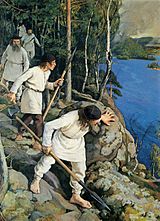
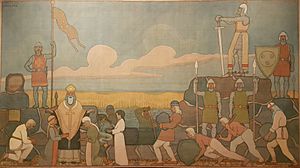
Sweden and Finland had contact even before Christianity. Vikings traded and raided. There might have been Viking settlements in Finland. The Åland Islands likely had Swedish settlers during the Viking Age.
Christianity became common in Finland in the 11th century. By the 12th century, the church was still growing. Legends from the 13th century describe Swedish attempts to conquer and Christianize Finland around 1150.
In the early 13th century, Bishop Thomas became the first known bishop of Finland. Several powers wanted to control Finnish tribes. These included Sweden, Denmark, and Novgorod (in Russia). Finns had their own chiefs but no central government. Finland had three main cultural groups: Finns, Tavastians, and Karelians.
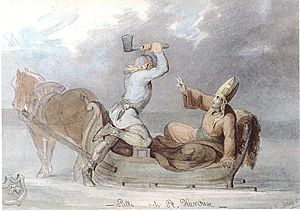
Birger Jarl, a Swedish leader, is said to have established Swedish rule in Finland. This happened during the Second Swedish Crusade, around 1249. This crusade was aimed at the Tavastians.
Novgorod took control of Karelia in 1278. Sweden gained control of Western Karelia in 1293. The border between Catholic (Swedish) and Orthodox (Russian) areas was set in 1323. This was with the Treaty of Nöteborg.
During the 13th century, Finland became part of European culture. The Dominican order arrived around 1249. Turku grew into an important town. It was one of Sweden's biggest towns. German merchants lived there. Most of Finland was rural. Sami hunters and fishermen lived in other parts. Many Swedish settlers moved to the coasts of Finland. They also moved to the Åland Islands. Swedish is still spoken in these areas today. It also became the language of the upper class.
The name "Finland" first meant only the southwestern area. This area is now called Finland Proper. The term "Österlands" (Eastern Lands) was used for the eastern part of Sweden. This included Finland Proper, Tavastia, and Karelia. In the 15th century, "Finland" started to mean the whole area.
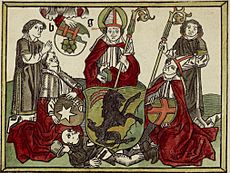
The bishopric of Turku was set up in the 13th century. Turku Cathedral was its center. The bishop was often the most powerful person in Finland. In 1362, representatives from Finland joined the election for the Swedish king. This is often seen as when Finland officially joined Sweden.
The strong fortress of Vyborg guarded the eastern border. Sweden and Novgorod signed a peace treaty in 1323. But conflicts continued. The Principality of Moscow conquered Novgorod. This led to a war between Sweden and Russia from 1495 to 1497. Viborg fortress survived a Russian attack.
The 1500s: Reformation and Growth
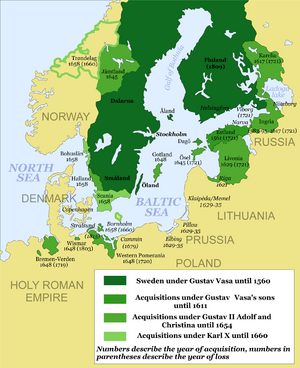
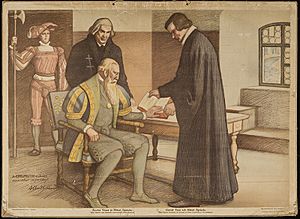
The Kalmar Union broke apart in 1521. Gustav Vasa became King of Sweden. During his rule, the Swedish church was reformed. The government also became much stronger. In 1551, Mikael Agricola, Bishop of Turku, published the New Testament in Finnish.
Helsinki was founded by Gustav Vasa in 1550. But it remained a small fishing village for a long time.
King Gustav Vasa died in 1560. His son, Erik XIV, started an era of expansion. Sweden took control of Tallinn in Estonia. This led to the Livonian War, which lasted 160 years. Finnish people suffered from high taxes and military abuse. This caused the Cudgel War (1596–1597). This was a peasant rebellion that was put down very cruelly. A peace treaty with Russia in 1595 moved Finland's border further east.
More farmers settled in central Finland in the 1500s. This often pushed out the original Sami population. It also led to fighting between Finnish settlers and Karelians.
The 1600s: Empire and Hardship
King Gustavus Adolphus ruled Sweden from 1611 to 1632. He made the Swedish army very strong. Sweden became one of Europe's most powerful countries. Finnish soldiers, called Hakkapeliitat, fought in the Thirty Years' War in Germany.
During this time, important changes happened in Finland:
- Count Per Brahe the Younger was governor of Finland. He made many reforms and founded new towns.
- In 1640, Finland's first university, the Academy of Åbo, was founded in Turku.
- In 1642, the whole Bible was published in Finnish.
However, high taxes, constant wars, and a cold climate made life hard for Finnish peasants. From 1655 to 1660, the Northern Wars took Finnish soldiers to other countries.
In the late 1600s, a lot of tar was made in Finland for export. This was needed for ships. The 17th century was a time of strict Lutheran beliefs. Everyone had to follow the Lutheran faith. The church also encouraged people to learn to read the Bible.
From 1696 to 1699, a terrible famine hit Finland. About one-third of the population died. Soon after, the Great Northern War (1700–1721) began.
The 1700s: Wars and New Ideas
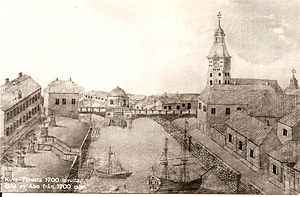
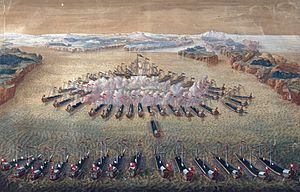
The Great Northern War (1700–1721) was very destructive. Finland was a battlefield. Famine and disease killed almost half the population. Russia won the war. It took the southeastern part of Finland, including Vyborg. Sweden lost its power in Europe.
Finland's population grew quickly after the war. By 1749, it was 427,000. By 1800, it had doubled. Most people were free farmers. Society had four groups: peasants, clergy, nobles, and townspeople. Peasants had political rights and were represented in parliament.
During the Lesser Wrath (1741–1742), Russia occupied Finland again. The border moved further west. Russian leaders even suggested creating a separate Finnish kingdom.

The late 1700s brought new ideas and development to Finland. Potato farming started after the 1750s. New inventions appeared, like the first hot air balloon in 1784. Trade increased, and farmers became wealthier. The Age of Enlightenment brought more discussion about politics and society. Most Finns spoke only Finnish. But newspapers and books were mostly in Swedish or French.
The Russian occupations made Finns feel separate. Some scholars in Turku began to think of a unique Finnish identity. By the early 1800s, many educated Finns were ready for a change to Russian rule.
King Gustav III of Sweden was killed in 1792. His son, Gustav IV Adolf, became king. He struggled to lead Sweden during the Napoleonic wars.
The Finnish areas that Russia took in 1721 and 1743 were called "Old Finland". They kept Swedish laws at first. But Russian rulers later gave land to their friends. This ignored Finnish laws and hurt the economy. In 1812, "Old Finland" was joined with the rest of Finland.
Peasants' Lives
Finnish villages managed their own affairs. They used local meetings called "ting." These meetings chose a "lawman" to enforce rules. The Swedish government used church parishes to collect taxes.
Unlike in other parts of Europe, Finnish peasants were usually free. They owned their own land. They were not tied to the land like serfs. Peasants were one of the four groups in society. They had representatives in parliament. However, upper classes often looked down on them.
Peasants were proud of their traditions. They fought to keep their rights. The Cudgel War (1596–1597) was a peasant revolt against nobles. After 1800, more people meant more poor farmers.
Finland as a Grand Duchy Under Russia
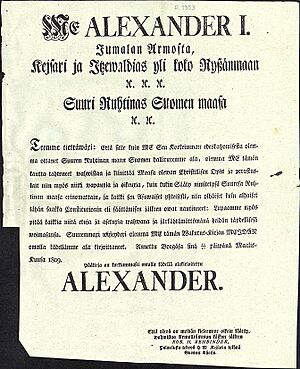
During the Finnish War, Russia conquered Finland. The Finnish groups met at the Diet of Porvoo in 1809. They promised loyalty to Tsar Alexander I of Russia. Finland became a Grand Duchy within the Russian Empire until 1917. The Tsar was the Grand Duke. Russia added Karelia to the Grand Duchy in 1812. Finland had some independence under Russian rule. The old Swedish laws stayed in place. Finns did not have to serve in the Russian army.
Growing Economy
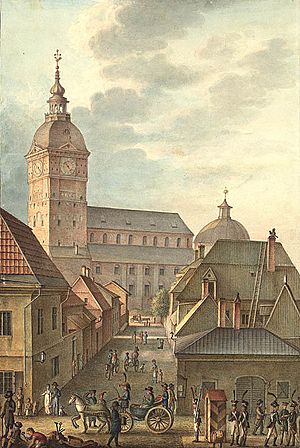
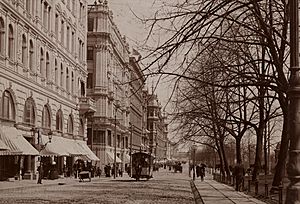
Before 1860, wealthy merchants and landowners invested in new businesses. After 1860, the government made economic laws more open. It also built ports, railroads, and telegraph lines. Industries grew quickly, especially those using forest resources. This laid the groundwork for Finland's wealth today.
Industrialization started in Helsinki. Alfred Kihlman helped gather money for new companies. In 1869, he helped start the Nokia company. After 1890, industrial growth slowed. But trade with Russia increased.
Rise of Nationalism

Finnish nationalism grew in the mid-1800s. Swedish-speaking upper classes wanted to promote Finnish culture and language. This helped unite people in Finland. The publication of the Kalevala in 1835 was very important. This national epic, a collection of old stories, sparked nationalism. It later led to Finland's independence.
Swedish was spoken by about 15% of the population. It was the language of government and education. Only peasants spoke Finnish. But in the 1800s, Finnish nationalism helped the Finnish language become more important. Russian officials also supported this to separate Finns from Sweden.
In 1863, Finnish became an official language. By 1892, it was equal to Swedish. Still, Swedish remained the language of culture and business until the 1920s.
The nationalist movement began with the Fennoman movement. Johan Vilhelm Snellman led it in the 1830s. He wanted to make Finnish the language of schools. This movement became the Finnish Party.
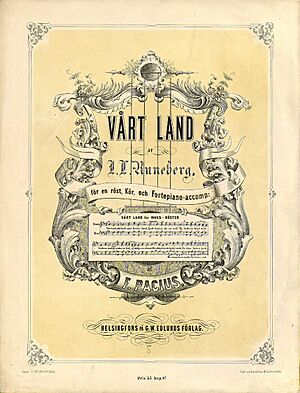
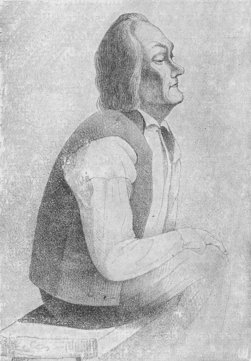
Liberal ideas also grew. Liberals wanted more democracy. They pushed for social democracy, labor unions, and women's rights. Nationalism sometimes clashed with the labor movement.
Religion in the Grand Duchy
Under Russian rule, Lutheranism and Eastern Orthodoxy were official religions. The Evangelical Lutheran Church of Finland separated from the Church of Sweden. Most Finns were Lutheran. But there was an old Orthodox minority in Karelian Isthmus. Monasteries like Valaam were important Orthodox centers. Orthodox churches were also built in Finnish towns. Other religions like Catholicism, Judaism, and Islam came with Russian soldiers and merchants.
Finnish leaders saw Orthodoxy and Catholicism as threats. They wanted to protect the Lutheran faith.
Music Development
Before 1790, music was mainly in churches and folk traditions. In 1790, the Åbo Musical Society was founded. This helped serious music grow. In the 1880s, new music schools and orchestras appeared. Finland became part of European music. Jean Sibelius (1865–1957) was the most important composer. His symphony Kullervo (1892), based on the Kalevala, was seen as truly Finnish music.
Political Changes
The Grand Duchy was not a democracy. The tsar had supreme power. He ruled through a governor general. The Diet of the Estates (parliament) was dissolved in 1809. It did not meet again for 50 years. Tsar Alexander II brought it back in 1863. The Diet then passed laws that modernized Finland. This prepared the country for independence.
Russification Efforts
Russia tried to limit Finland's special status. This policy was called Russification (1899–1905 and 1908–1917). Finns called it "times of oppression." Key parts of this policy included:
- The February Manifesto (1899): Russia could rule Finland without local consent.
- The Language Manifesto (1900): Russian became the language of Finnish government.
- The conscription law (1901): The Finnish army joined the imperial army.
Finns strongly resisted these changes. They used passive resistance and strengthened their Finnish identity.
Democratic Steps
In 1906, the old four-chamber Diet was replaced. A new single-chamber Parliament of Finland (the Eduskunta) was created. For the first time in Europe, women gained the right to vote and run for office. This was a big step for democracy. However, local elections still favored the rich. This changed to equal voting rights in 1917.
Emigration from Finland
Many Finns left the country between 1890 and 1914. Most went to the United States and Canada. They often worked in lumber and mining. Today, many Americans and Canadians have Finnish ancestors.
Independence and Civil War

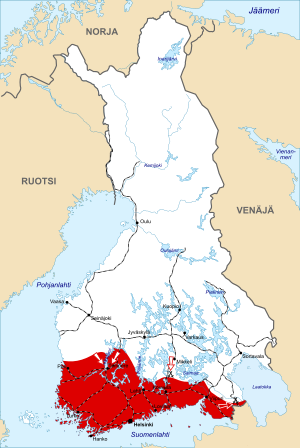
After the Russian Revolution in February 1917, Finland got a new government. The Social Democrats had a small majority. Oskari Tokoi became prime minister. Finland believed its connection to Russia was over. But the Russian government disagreed.
Finnish Social Democrats wanted full independence. Non-Socialists wanted to work with Russia. This disagreement led to the Social Democrats leaving the government. Russia then dissolved the Finnish Parliament. New elections were held, and non-Socialists won. This caused anger among Socialists.
Finland Declares Independence
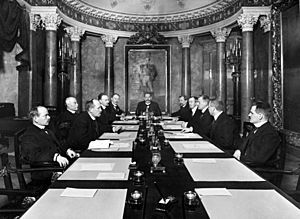
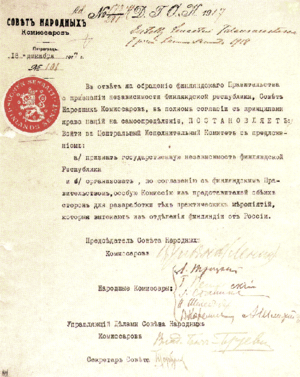
The October Revolution in Russia changed everything. The new non-Socialist majority in Finland wanted full independence. On November 15, 1917, the Bolsheviks in Russia declared self-determination for all peoples. The Finnish Parliament then took power.
Finland's non-Socialist government proposed declaring independence. The Parliament voted for it on December 6, 1917. The Soviet government recognized Finland's independence on December 31. Germany and Scandinavian countries quickly followed.
The Finnish Civil War
Finland was deeply divided after 1917. The "Whites" were mostly Swedish-speaking middle and upper classes. They were conservative and against socialism. The "Reds" were Finnish-speaking urban workers and poor farmers. They were radical and against capitalism.
From January to May 1918, Finland had a short but fierce Finnish Civil War. The "Whites" fought the "Reds." Germany supported the Whites. Sweden stayed neutral, and Russia pulled out its troops. The Reds lost the war. About 37,000 people died, many in prison camps.
Finland Between the World Wars

After the civil war, the "White" parliament wanted a king. They chose a German prince. But Germany lost World War I, so this plan failed. Finland became a republic. Kaarlo Juho Ståhlberg was elected its first President in 1919. Despite the civil war, Finland remained a capitalist democracy.
Land Reform
In the 1920s, large land reforms happened. Big estates owned by nobles were broken up. The land was sold to ambitious peasants. These farmers became strong supporters of the government.
International Relations
Finland joined the League of Nations in 1920. It had a dispute over the Åland Islands. Most people there spoke Swedish and wanted to join Sweden. Finland kept the islands but gave them special self-rule. An international treaty made Åland a neutral area.
Prohibition in Finland
Finland tried to ban alcohol in 1919. But smuggling and crime increased. Public opinion turned against the law. In 1932, a public vote ended prohibition.
Political Movements
Nationalist feelings from the Civil War led to the Lapua Movement in 1929. This was a proto-Fascist group. It was popular among anti-Communist Finns. But after a failed coup in 1932, it was banned.
Relations with the Soviet Union
There were many small conflicts along the border after the Civil War. Relations improved with the Treaty of Tartu in 1920. Finland gained Petsamo but gave up claims to East Karelia.
The Soviet Union became stricter with Finland in the 1930s. It limited Finnish ships on Lake Ladoga.
Finland in World War II
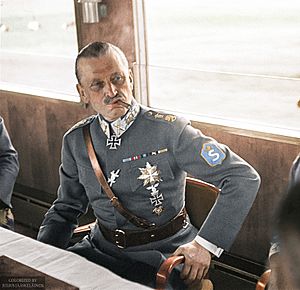
In August 1939, Germany and the Soviet Union signed a pact. Finland was placed in the Soviet "sphere of influence." The Soviet Union demanded military bases from Finland. Finland refused these demands.
The Soviet Union invaded Finland on November 30, 1939. This started the Winter War. The Soviets wanted to take over Finland. But the Red Army faced strong resistance. They lost many battles. After two months, the Soviets stopped trying to set up a puppet government. They recognized Finland's real government. Fighting ended on March 13, 1940, with the Moscow Peace Treaty. Finland kept its independence. But it lost 9% of its land. The Soviet Union was expelled from the League of Nations.

After the Winter War, Finland needed support. In late 1940, Germany offered weapons. Finland agreed to let German troops travel through its land. Military cooperation began.
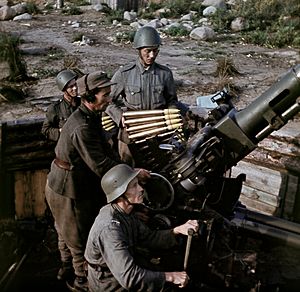
Hostilities started again in June 1941. This was the Continuation War. Finland joined Germany after Germany invaded the Soviet Union. Finland occupied East Karelia. This made other countries less sympathetic to Finland.
Finnish forces won important battles in 1944. These victories helped Finland keep its independence. They led to the Moscow Armistice with the Soviet Union. Finland had to expel German troops from northern Finland. This led to the Lapland War.
Finland was never occupied by Soviet forces. It lost about 96,000 soldiers. This was 2.5% of its population. Finland kept its democracy. But it had to pay large reparations and resettle many people. It lost one-eighth of its land, including Vyborg.
The Finnish government did not take part in the killing of Jews. Finland was a "co-belligerent" with Germany. But it was not officially an Axis nation. The Allies agreed that Finland was fighting a separate war. Finland signed a separate armistice with the Soviet Union in September 1944. It was the only country bordering the USSR in Europe that stayed independent.
About 80,000 Finnish children were sent abroad during the wars. Most went to Sweden. Many returned by 1948.
The Moscow Armistice ended the Continuation War. It forced Finland to drive out German troops.
In 1947, Finland refused Marshall aid from the US. This was to keep good relations with the Soviets. But the US secretly sent aid to the Social Democratic Party. Paying reparations to the Soviet Union helped Finland become an industrial country.
Finland's role in World War II was unusual. The Soviet Union could not conquer Finland in 1939. Finland cooperated with Germany but never joined the Tripartite Pact. Finland was a democracy throughout the war. Carl Gustaf Emil Mannerheim, the Finnish commander, became President.
War Memorials
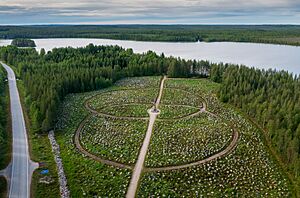
Finland lost land in the wars. But the memory of these wars is strong. Finland sees them as a victory for its national spirit. Many groups are remembered today. These include soldiers, veterans, orphans, and women who worked during the war.
Post-War Finland and the Cold War
Neutrality in the Cold War
Finland kept its democracy and free economy during the Cold War. Treaties with the Soviet Union in 1947 and 1948 limited Finland. The Paris Peace Treaty (1947) limited Finland's army size. The Finno-Soviet Treaty of 1948 (1948) was key. It said Finland would talk with the Soviets if Germany or its allies attacked. Both treaties ended after the Soviet Union broke up in 1991.
Finland became closer to other Nordic countries. It declared itself neutral in superpower politics. President Juho Kusti Paasikivi believed Finland needed to assure the Soviet Union it was not a threat. This meant staying neutral and having strong defenses.
In 1952, Finland joined a passport union with Nordic countries. People could cross borders without passports. Many Finns moved to Sweden for better jobs. Finland's economy grew a lot after World War II. It built a Nordic-style welfare state.

Finland could not join the Nordic Council until 1955. The Soviets feared it would get too close to the West. In 1955, Finland joined the United Nations. Also in 1955, the Soviet Union returned the Porkkala peninsula to Finland. This area had been a Soviet military base.
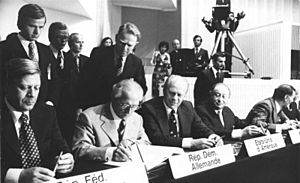
Finland was officially neutral. But it was also a center for Cold War espionage. Both the KGB and CIA were active. Finland's own security service also took part. The 1948 treaty gave the Soviet Union some influence in Finnish politics. But Finland kept capitalism. Property rights were strong.
Finland joined international free trade agreements. It became an associate member of the European Free Trade Association in 1961. It also made an agreement with the European Community in 1973. Finland's economy grew rapidly. By the early 1970s, Finland's wealth was similar to Japan and the UK.
Finland worked to reduce Cold War tensions. It pushed for a Nordic Nuclear Weapons Free Zone. In 1972–1973, Finland hosted the Conference on Security and Cooperation in Europe (CSCE). This led to the Helsinki Accords in 1975.
Society and the Welfare State

Before 1940, Finland was a poor, rural country. Most people were farmers or workers. By 1950, half the workers were still in agriculture. But new jobs in factories and services drew people to cities. Birth rates fell. Many young people moved to Sweden for jobs.
By the 1990s, few people worked on farms. Society changed. There was a working class, a middle class, and an upper class. These groups were not strictly separate. Mass culture, social mobility, and democracy changed society.
Finland developed a generous welfare system. It provides old-age and disability insurance. The government offers unemployment benefits, maternity benefits, and family allowances. Health insurance covers most medical costs. Free health centers were set up in every town.
Economic Growth and Challenges
After World War II, Finland had fast economic growth. It became a technologically advanced country. It had a strong market economy and high living standards.
In 1991, Finland faced an economic depression. This was due to several factors. The stock market and housing prices fell by 50%. The economy had grown too fast with debt. Unemployment rose sharply. The government struggled to cut spending. The crisis ended in 1993 after currency devaluations.
Post-Cold War History
Finland's economy has grown quickly since the depression. It has topped many global performance lists.
Until 1991, Finland's leaders were against joining the European Union. But after Sweden applied in 1991 and the Soviet Union dissolved, Finland applied in March 1992. There was a big public debate. A vote in 1994 showed 56.9% were in favor of joining. Finland joined the European Union on January 1, 1995.
Joining the EU brought big economic changes. The Bank of Finland was given more control over interest rates. Many state companies were privatized.
Finland has also strengthened its military. It is now compatible with NATO. Finland has troops in NATO and UN operations. For a long time, Finland was one of the last non-NATO countries in Europe. It did not want to join unless Sweden did first.
On February 24, 2022, Russia invaded Ukraine. A Russian spokesperson threatened Finland and Sweden if they tried to join NATO. After the invasion, public support for NATO membership grew a lot in Finland.
On April 4, 2023, Finland officially joined NATO. It became the 31st member.
Historical Population of Finland
- 1150: 20,000–40,000
- 1550: 300,000
- 1750: 428,000
- 1770: 561,000
- 1790: 706,000
- 1810: 863,000
- 1830: 1,372,000
- 1850: 1,637,000
- 1870: 1,769,000
- 1890: 2,380,000
- 1910: 2,943,000
- 1930: 3,463,000
- 1950: 4,030,000
- 1970: 4,598,000
- 1990: 4,977,000
- 2010: 5,375,000
- 2015: 5,500,000
- 2020: 5,531,000
|
- Diplomatic history of World War II#Finland
- Early Finnish wars
- Finns
- Finland–Russia relations
- Finland under Swedish rule
- Henrik Gabriel Porthan
- Kvenland
- List of Finnish treaties
- List of presidents of Finland
- List of prime ministers of Finland
- List of wars involving Finland
- Military history of Finland
- Monarchy of Finland
- Politics of Finland
- Timeline of Finnish history
See also
 In Spanish: Historia de Finlandia para niños
In Spanish: Historia de Finlandia para niños



